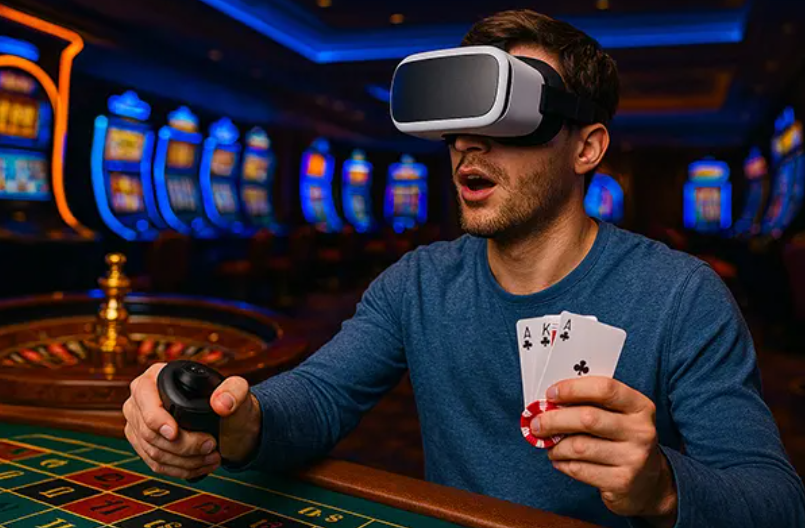Let’s be honest — casino nights at home used to mean a laptop, a frozen livestream, and the faint sound of someone coughing near a webcam dealer in Malta. Not exactly Vegas. But those days? They’re slipping into the past faster than a losing hand at blackjack.
The next wave of online gambling isn’t just about sharper graphics or faster internet. It’s about presence. About walking into a casino that doesn’t technically exist — and still feeling the air hum with tension as you watch the wheel spin. Welcome to the era of live dealer casinos meeting AR and VR — where the chips may be digital, but the adrenaline is very, very real.
Reality, But Turned Up a Notch
Remember when “live casino” meant a dealer on a screen and maybe a chat box where someone typed “nice hand”? That was cute — like the training wheels version of what’s coming. Now, with Virtual Reality, you’re not just watching a dealer. You’re sitting across from them. You can see the flicker of light on the cards, the subtle raise of an eyebrow when you hit on 17, the other players leaning in with that same mix of greed and hope.
Augmented Reality takes it even further — blending the virtual with your real space. Imagine this: you’re at your kitchen table, morning coffee in hand, and suddenly it’s a blackjack table. You reach out, touch your cards (okay, holographic cards), and there’s a live dealer greeting you by name. It’s absurdly close to reality — just without the jet lag or the smell of stale cigar smoke.
Why It Works: The Brain Believes the Lie
There’s something delightfully primal about it. Your brain knows it’s a simulation, but it doesn’t care. The lights, the sounds, the human faces — it all tricks your senses just enough to release that little dopamine hit gamblers chase.
Casinos have always been about illusion. The way time disappears inside them, how you forget what day it is. VR and AR simply take that illusion digital. And the results are powerful. Players feel less like customers and more like participants in a shared moment — a poker table that lives somewhere between code and consciousness.
At slotsgem casino online, this line is already blurring. The platform’s hybrid live games blend real dealers with interactive 3D spaces, creating something weirdly cinematic — like Ocean’s Eleven meets the Metaverse. Two clicks, and you’re standing in a virtual Monte Carlo suite, watching a real human shuffle cards in real time. It’s gambling, but reimagined as performance art.
The Tech Behind the Trick
The secret sauce here isn’t just fancy visuals. It’s immersion engineering.
- Spatial audio makes it sound like people are around you — chatting, shuffling chips, calling bets.
- Haptic feedback lets you feel a vibration when your chips clack together.
- Motion sensors mirror your real-life gestures in the game — nodding to the dealer or raising a virtual glass after a win.
- And with 5G and low-latency streaming, there’s almost no lag. You’re in sync with the live table as if you were right there, elbow to elbow with everyone else.
It’s technology built not just to impress your eyes, but to fool your body into forgetting where it actually is.
The Human Element Returns
One of the strangest things about online gambling has always been how lonely it can feel. Sure, you’re playing — but who are you playing with? In AR and VR casinos, that isolation melts away.
You can talk, laugh, and even flirt a little with the dealer. You can see avatars of other players shifting in their seats. You might even recognize the same crowd showing up night after night. It’s a digital casino, yes — but it hums with human energy.
Some players have described it as “the pub version of Vegas.” And they’re right. It’s social again. Messy again. Alive again.
Of Course, There’s a Catch
Every utopia has a fine print. Not everyone has a VR headset. Some people get dizzy after five minutes in the virtual casino. And the tech is still finding its rhythm — a few bugs here, a lag there.
Then there’s the regulatory question: when gambling becomes that immersive, where’s the line between entertainment and addiction? Policymakers are scrambling to figure it out. Because when you can step into a casino as easily as opening Netflix, temptation becomes a 3D experience too.
But honestly? Every big shift in gaming has come with a little chaos. Remember when online poker first appeared, and everyone swore it would end civilization? Now it’s just Tuesday.
Tomorrow’s Casino Is Already Here
Picture this. You come home from work. You drop your bag, put on your AR glasses, and say: “Let’s play.” Instantly, your living room transforms. A roulette table spins in front of you, the dealer smiles, and your friends appear as avatars beside you, laughing and betting.
You’re still at home — but somehow, you’re also somewhere else entirely. Somewhere with the glamour of Vegas, the intimacy of a private club, and the infinite possibilities of code.
And when you win? The thrill hits exactly the same way it does when real chips hit a real table. Because your brain doesn’t care what’s real anymore. It just knows it feels good.
The House Always Evolves
The history of casinos is a story of reinvention — from smoky rooms to neon towers, from desktop screens to wearable realities. AR and VR aren’t the end of that journey; they’re the next chapter.
We’re heading toward an era where casinos won’t just show you the game — they’ll pull you inside it. And whether you’re in it for the thrill, the company, or just to escape reality for a while, one thing’s certain: the line between player and world is about to vanish.
So go ahead. Put on the headset. The dealer’s waiting.


















